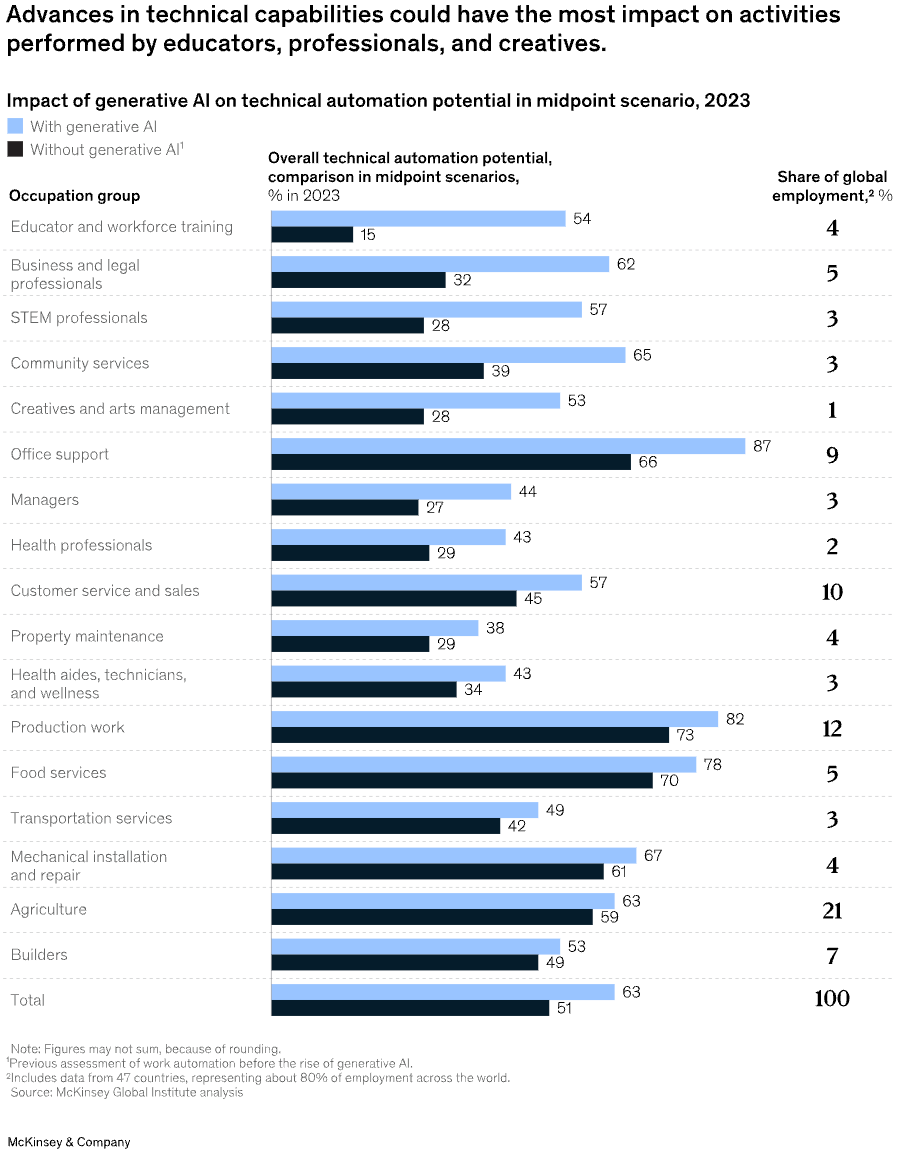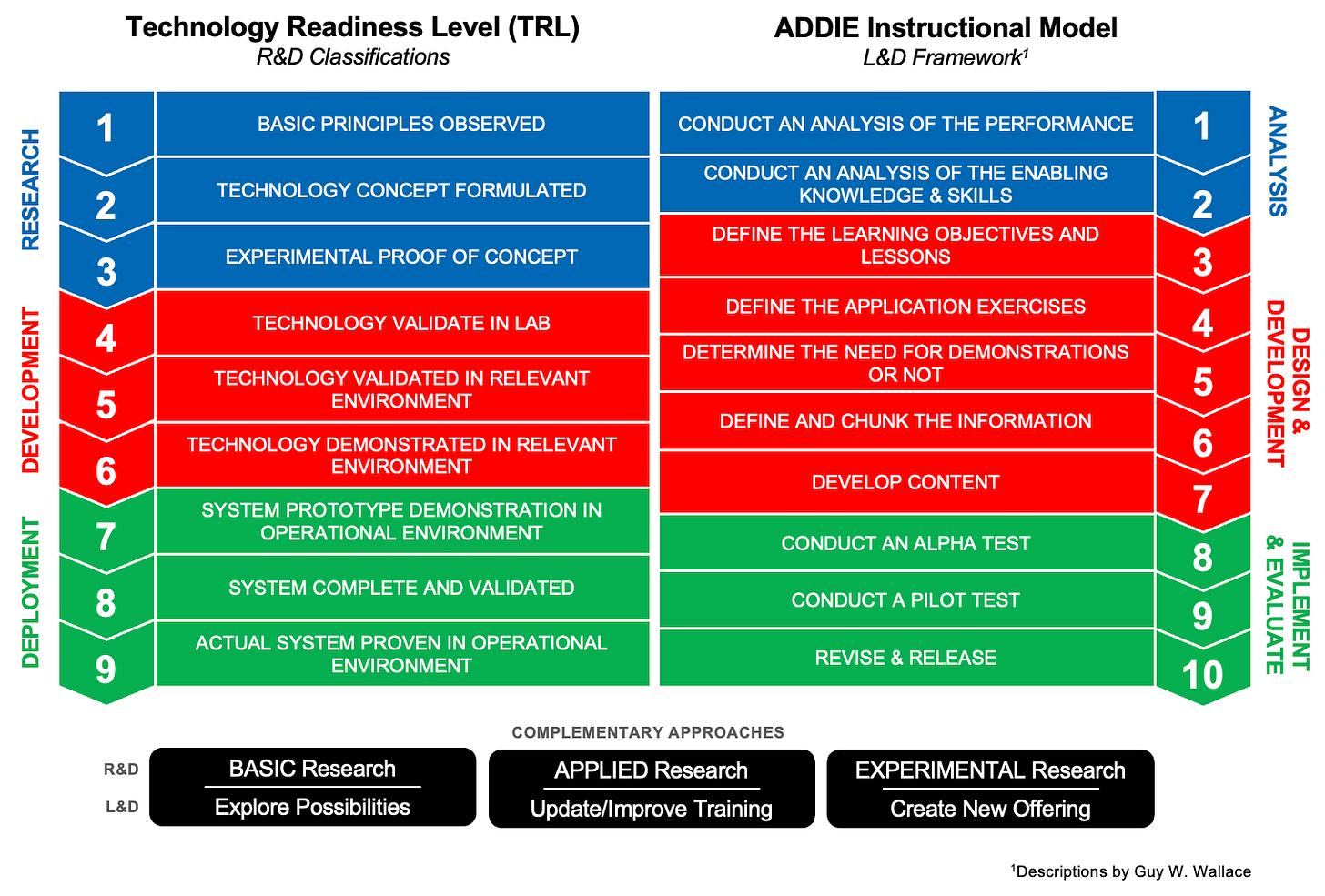Learning & Development is the New Research & Development: How the Learning Function Can be the AI Accelerator
This is Part 1 regarding the Learning & Development function investigating, testing and extending the use of AI within your company. Part 2 shares practical approaches here.
An argument to consider:
No other entity in the enterprise is best positioned by charter and capability to disrupt and accelerate AI’s benefits than the company’s Learning & Development function.
Our tradition of research, synthesizing user/learner needs, prototyping, measurement etc. is akin to formal Research and Development or R&D attributes. With this in mind…
L&D is the new R&D.
The Learning and Development function (L&D) has a tradition and charter to enable growth, help companies and workers stay relevant via future-ready skilling, and to attract and retain talented people. Our legacy of providing learning opportunities to sustain both company culture and profitability remains with durability and duty. All that may still be true, but in the age of AI, is there something more?
Generative AI will pose a dilemma: a threat to L&D and related jobs, but also an opportunity. Is there something in the DNA of a learning team that can provide unique perspective and insight to find a new voice or seat at the proverbial Executive Table? Maybe, with some provocation, has L&D become The Table, a new center of gravity?
We already have a tradition of analyzing needs and gaps, designing and prototyping, aligning to learner/consumer demands, and managing portfolios and pipelines. These activities look very similar to another function, Research and Development.
“This era of transformational change is L&D’s call-to-action as a practice. Our function is now the most critical for the enterprise. We have a massive skills deficit across the workforce at all levels and we need to lead the effort to close the seams in capability.”
Brandon Carson, Chief Learning Officer, Starbucks
Does it all start with L&D? I think it can.
In recent research by McKinsey, GenAI may provide the greatest impact and potential for educators than any other occupation. Leveraging data from 47 countries, and representing roughly 80% of all employment globally, our L&D or “Educators and Workforce Training” employees have the highest “technical automation potential” than any other occupational group.1
With this in mind, L&D is well-positioned to be the tracks on which this AI/GenAI train can accelerate the best of what L&D can offer, and extend across the enterprise.
How Research & Development Complements Learning & Development
For L&D to be at the forefront we need to think differently about how we both envision our roles and how we measure our impact. The Frascati Manual is a document published by the Organization for Economic Co-operation and Development and is considered the standard for research and development studies and practices.
While the manual and guidelines highlight a variety of fields or classifications, there has been--and I’d argue will always be--an inherent marriage with the use of R&D practices with education and training. This is particularly keen in higher education institutions where the formality of research, creating a thesis, crafting strong feasibility and argument etc. is intrinsic in attaining one’s academic or vocational goal such as a doctorate, or perhaps defending arguments to pass a bar exam and more.
The Frascati Model references an R&D process called the Technology Readiness Level or TRL, which provides a more practical set of steps many industries leverage for both Experimental R&D (not sure what the outcome may provide) and Applied R&D (where you have a known objective).
Where’s the complement?
The complement may lie with the most common denominator or universal approach for crafting effective corporate learning solutions or the traditional ADDIE model.
If we were to map or align the Frascati TRL approach with ADDIE, the alignment would look like this….
My Take on Complementing R&D and L&D Approaches
In part 2 of this series, we’ll explore various considerations or approaches on how to best use this blend from a practitioners’ perspective.
For now, we are experiencing a significant amount of momentum to reinvent L&D–in practice, tools, workflows and skills. While this disruption is inevitable and healthy, we must also recognize there are many legacy behaviors that constrain our growth and ability to provide value.
We remain reactionary to business needs and the business’ assumptions that consumption for example is the best indicator of effectiveness. We react to whomever has the highest rank or loudest voice, versus building analytics and insights to identify the truth. We believe that success means scale, speed and savings, versus the new AI economy informing us it’s all about iteration, context and collective decision making.
Artificial Intelligence and GenAI tools are our new springboard and our responsibility for the enterprise, and perhaps our communities and society.
Be proud, step up, this is our time.
Research and develop, to learn and develop.
Part 2 of our L&D is the New R&D series is here.
Significant thanks for support and inspiration: Brandon Carson, Donald Clark, Gianni Giacomelli, Dr. Philippa Hardman, Dani Johnson, Cassie Kozyrkov, Ethan Mollick, Mark Oehlert, Noah G. Rabinowitz, Raffaella Sadun, Julian Stodd, Donald H. Taylor, Egle Vinauskaite, Marc Zao-Sanders and so many more.
References
1 The economic potential of generative AI: The next productivity frontier (June 14, 2023)
The Measurement of Scientific, Technological and Innovation Activities: Frascati Manual 2015
Organization for Economic Co-operation and Development (Wikipedia)







